Analys
Metals price forecast: Lower Before Higher

Lower before higher

The world is slowing down along with fiscal and monetary tightening. The rapid rise in interest rates this year will work with a lag so the slowdown in the real economy is likely to continue. We expect metals prices to ease along with that. The continued deterioration in the Chinese property market is likely structural with growth shifting towards higher value sectors including green energy and EVs. Chinese credit expansion has started. Stronger demand for metals like copper, nickel and aluminium is likely to emerge in H2-23. Strong prices for metals over the coming decade due to sub-par capex spending over the past decade is likely.

Weakening macro and weakening demand. The world is now in the grip of a tightening craze amid inflation panic which was the result of the stimulus boom ignited by Covid-19 panic. The US expanded its M2 monetary base by 30% of GDP during the stimulus boom. Donald Trump earlier clamped down on immigration from Mexico/Latin America. Rampant consumer spending on capital goods together with an ultra-tight labor market then led to intense inflation pressure in the US. But also, in many other countries which also stimulated too much. The US is ahead of the curve with respect to interest rate hikes. The USD has rallied, forcing many central banks around the world to lift rates to defend their currencies as well as fighting their own inflationary pressures. The Japanese central bank has refrained from doing so and has instead intervened in the yen currency market for the first time since 1998. The year 2022 will likely be the worst selloff in global government bonds since 1949 as interest rates rise rapidly from very low levels. This is taking place following a decade where the world has been gorging on ultra-cheap debt. There is clearly a risk that something will break apart somewhere in the financial system as the world gallops through this extreme roller coaster ride of stimulus and tightening. On top of this we have and energy crisis in Europe where natural gas prices for year 2023 currently is priced at 700% of normal levels. War in Ukraine, risk for the use of nuclear weapons, an enduring cool-down of the Chinese property market and continued lock-downs in China due to Covid-19 is adding plenty of uncertain elements.
Downside price risks for metals over the coming 6-9 months. The significant rise in rates around the world will work with a lag. There can be up to a 12-month lag from rates starts to rise to when they take real effect. Continued economic cool-down in the economy is thus likely. Chinese politicians seem unlikely to run yet another round of property market-based stimulus. As such there are clearly downside risks to global economic growth and industrial metals prices over the coming 6 months.
China may be a “White Swan Event” in H2-23 onward. LME’s China seminar in London on Monday 24 October this year was very interesting. The brightest spot in our view was Jinny Yang, the Chief China economist at ICBC Standard Bank. She stated that China may turn out to be a “white swan event” in H2-2023. Further that the Chinese economy now is on a decade long type of transition period. Away from property focused growth. With a shift instead to technology and innovation, telecoms and energy transition, consumer demand side economy and higher value and more advanced sectors. The property market will be a fading sector with respect to growth. Chinese politicians are fully committed to the energy transition. No slowdown in there. Credit expansion has already started. The real effect of that will emerge in H2-23. The new growth focus will be different from before. But it will still imply lots of metals like aluminium, copper, nickel, zinc, cobalt, manganese, and other special metals. There will be less copper for pipes and wiring for housing but there will be more copper for EVs, Solar power, Wind power and power networks etc.
Copper: Struggling supply from Chile, rising supply from Africa while Russian exports keeps flowing to market. The Chinese housing market normally accounts for 20% of global copper demand. So, slowing Chinese housing market is bad for copper. Russian exports keep flowing to SE Asia where it is re-exported. Good supply growth is expected from Africa in 2023. Supply from Chile is struggling with falling ore grades, political headwinds, and mining strikes. Demand is projected to boom over the coming decades while investments in new mines have been sub-par over the past decade. So strong prices in the medium to longer term. But in the short-term the negative demand forces will likely have the upper hand.
Nickel: Tight high-quality nickel market but surplus for low-quality nickel. There is currently a plentiful supply of low-grade nickel with weak stainless-steel demand and strong demand for high quality nickel for EV batteries. The result is a current USD 5-6000/ton price premium for high-quality vs. low-quality nickel. High-quality LME grade nickel now only accounts for 25% of the global nickel market. Over the coming decade there will be strong demand growth for high-quality nickel for EV batteries, but high-quality NiSO4 will take center stage. The price of high-quality nickel over the coming decade will depend on how quickly the world can ramp up low-grade to high-grade conversion capacity.
Aluminium: Russian production and exports keeps flowing at normal pace to the market through different routes. Supply from the western world set to expand by 1.3 m ton pa in 2023, the biggest expansion in a decade. Demand is projected to grow strongly over the decade to come with energy transition and EVs being strong sources of demand. Western premiums likely to stay elevated versus Asian premiums to attract metal. Increasing focus on low carbon aluminium. But weakness before strength.
SEB commodities price forecast:
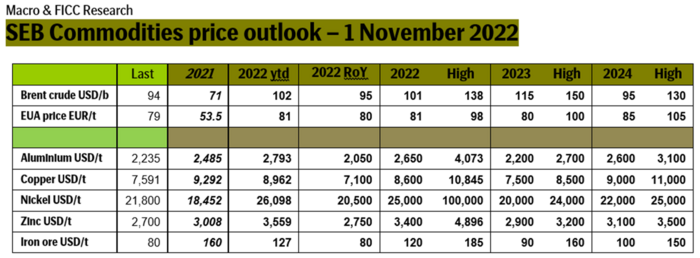
Chinese credit cycle vs industrial metals. Chinese credit expansion has already started.
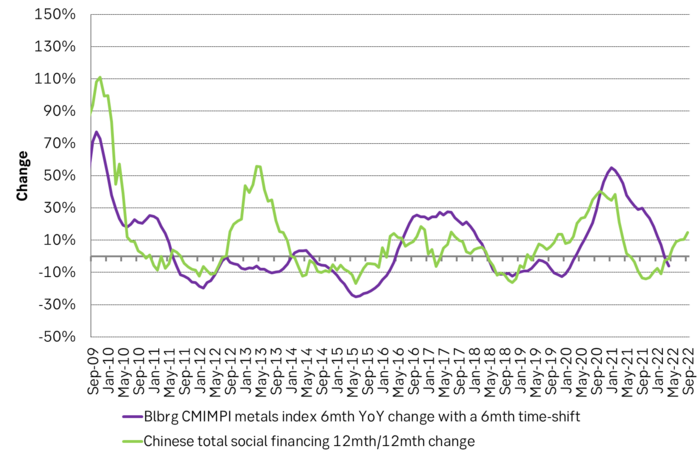
This report has been compiled by SEB´s Commodity Research, a division within Skandinaviska Enskilda Banken AB (publ) (”SEB”), to provide background information only.
Analys
Crude stocks fall again – diesel tightness persists

U.S. commercial crude inventories posted another draw last week, falling by 2.4 million barrels to 418.3 million barrels, according to the latest DOE report. Inventories are now 6% below the five-year seasonal average, underlining a persistently tight supply picture as we move into the post-peak demand season.

While the draw was smaller than last week’s 6 million barrel decline, the trend remains consistent with seasonal patterns. Current inventories are still well below the 2015–2022 average of around 449 million barrels.
Gasoline inventories dropped by 1.2 million barrels and are now close to the five-year average. The breakdown showed a modest increase in finished gasoline offset by a decline in blending components – hinting at steady end-user demand.
Diesel inventories saw yet another sharp move, falling by 1.8 million barrels. Stocks are now 15% below the five-year average, pointing to sustained tightness in middle distillates. In fact, diesel remains the most undersupplied segment, with current inventory levels at the very low end of the historical range (see page 3 attached).
Total commercial petroleum inventories – including crude and products but excluding the SPR – fell by 4.4 million barrels on the week, bringing total inventories to approximately 1,259 million barrels. Despite rising refinery utilization at 94.6%, the broader inventory complex remains structurally tight.
On the demand side, the DOE’s ‘products supplied’ metric – a proxy for implied consumption – stayed strong. Total product demand averaged 21.2 million barrels per day over the last four weeks, up 2.5% YoY. Diesel and jet fuel were the standouts, up 7.7% and 1.7%, respectively, while gasoline demand softened slightly, down 1.1% YoY. The figures reflect a still-solid late-summer demand environment, particularly in industrial and freight-related sectors.


Analys
Increasing risk that OPEC+ will unwind the last 1.65 mb/d of cuts when they meet on 7 September

Pushed higher by falling US inventories and positive Jackson Hall signals. Brent crude traded up 2.9% last week to a close of $67.73/b. It traded between $65.3/b and $68.0/b with the low early in the week and the high on Friday. US oil inventory draws together with positive signals from Powel at Jackson Hall signaling that rate cuts are highly likely helped to drive both oil and equities higher.

Ticking higher for a fourth day in a row. Bank holiday in the UK calls for muted European session. Brent crude is inching 0.2% higher this morning to $67.9/b which if it holds will be the fourth trading day in a row with gains. Price action in the European session will likely be quite muted due to bank holiday in the UK today.
OPEC+ is lifting production but we keep waiting for the surplus to show up. The rapid unwinding of voluntary cuts by OPEC+ has placed the market in a waiting position. Waiting for the surplus to emerge and materialize. Waiting for OECD stocks to rise rapidly and visibly. Waiting for US crude and product stocks to rise. Waiting for crude oil forward curves to bend into proper contango. Waiting for increasing supply of medium sour crude from OPEC+ to push sour cracks lower and to push Mid-East sour crudes to increasing discounts to light sweet Brent crude. In anticipation of this the market has traded Brent and WTI crude benchmarks up to $10/b lower than what solely looking at present OECD inventories, US inventories and front-end backwardation would have warranted.
Quite a few pockets of strength. Dubai sour crude is trading at a premium to Brent crude! The front-end of the crude oil curves are still in backwardation. High sulfur fuel oil in ARA has weakened from parity with Brent crude in May, but is still only trading at a discount of $5.6/b to Brent versus a more normal discount of $10/b. ARA middle distillates are trading at a premium of $25/b versus Brent crude versus a more normal $15-20/b. US crude stocks are at the lowest seasonal level since 2018. And lastly, the Dubai sour crude marker is trading a premium to Brent crude (light sweet crude in Europe) as highlighted by Bloomberg this morning. Dubai is normally at a discount to Brent. With more medium sour crude from OPEC+ in general and the Middle East specifically, the widespread and natural expectation has been that Dubai should trade at an increasing discount to Brent. the opposite has happened. Dubai traded at a discount of $2.3/b to Brent in early June. Dubai has since then been on a steady strengthening path versus Brent crude and Dubai is today trading at a premium of $1.3/b. Quite unusual in general but especially so now that OPEC+ is supposed to produce more.
This makes the upcoming OPEC+ meeting on 7 September even more of a thrill. At stake is the next and last layer of 1.65 mb/d of voluntary cuts to unwind. The market described above shows pockets of strength blinking here and there. This clearly increases the chance that OPEC+ decides to unwind the remaining 1.65 mb/d of voluntary cuts when they meet on 7 September to discuss production in October. Though maybe they split it over two or three months of unwind. After that the group can start again with a clean slate and discuss OPEC+ wide cuts rather than voluntary cuts by a sub-group. That paves the way for OPEC+ wide cuts into Q1-26 where a large surplus is projected unless the group kicks in with cuts.
The Dubai medium sour crude oil marker usually trades at a discount to Brent crude. More oil from the Middle East as they unwind cuts should make that discount to Brent crude even more pronounced. Dubai has instead traded steadily stronger versus Brent since late May.
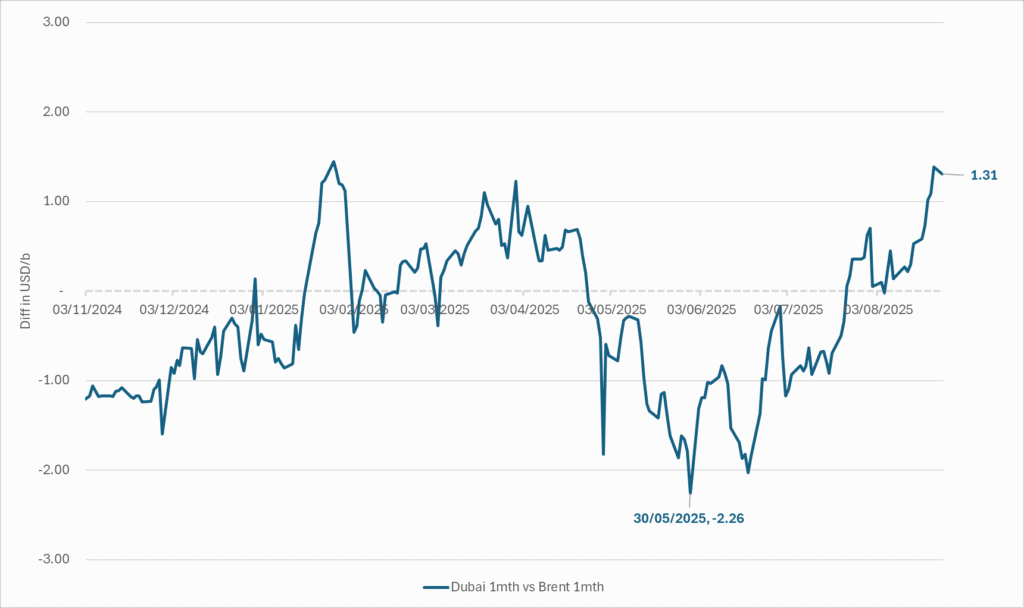
The Brent crude oil forward curve (latest in white) keeps stuck in backwardation at the front end of the curve. I.e. it is still a tight crude oil market at present. The smile-effect is the market anticipation of surplus down the road.
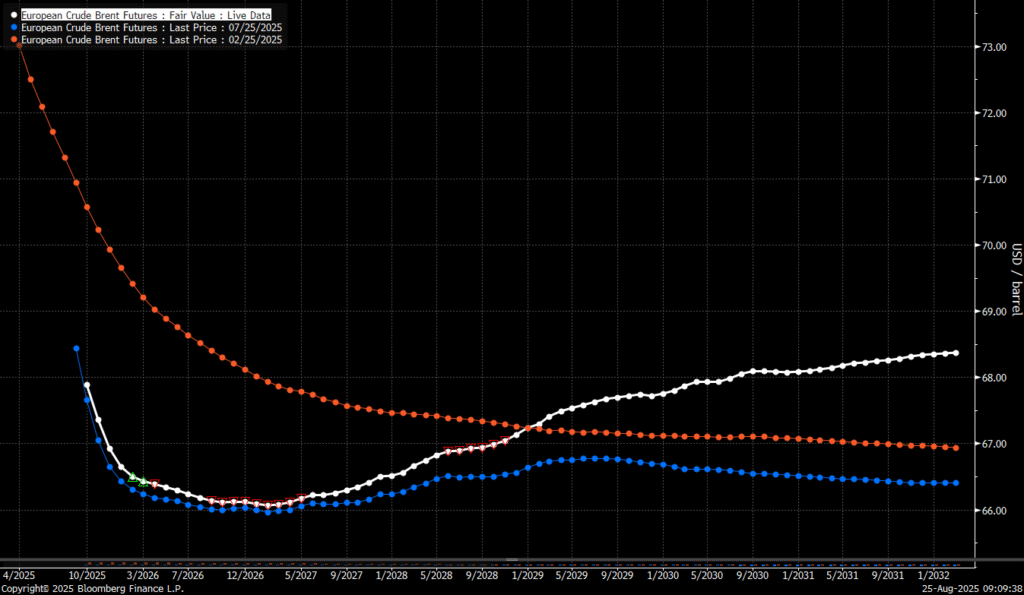
Analys
Brent edges higher as India–Russia oil trade draws U.S. ire and Powell takes the stage at Jackson Hole

Best price since early August. Brent crude gained 1.2% yesterday to settle at USD 67.67/b, the highest close since early August and the second day of gains. Prices traded to an intraday low of USD 66.74/b before closing up on the day. This morning Brent is ticking slightly higher at USD 67.76/b as the market steadies ahead of Fed Chair Jerome Powell’s Jackson Hole speech later today.

No Russia/Ukraine peace in sight and India getting heat from US over imports of Russian oil. Yesterday’s price action was driven by renewed geopolitical tension and steady underlying demand. Stalled ceasefire talks between Russia and Ukraine helped maintain a modest risk premium, while the spotlight turned to India’s continued imports of Russian crude. Trump sharply criticized New Delhi’s purchases, threatening higher tariffs and possible sanctions. His administration has already announced tariff hikes on Indian goods from 25% to 50% later this month. India has pushed back, defending its right to diversify crude sourcing and highlighting that it also buys oil from the U.S. Moscow meanwhile reaffirmed its commitment to supply India, deepening the impression that global energy flows are becoming increasingly politicized.
Holding steady this morning awaiting Powell’s address at Jackson Hall. This morning the main market focus is Powell’s address at Jackson Hole. It is set to be the key event for markets today, with traders parsing every word for signals on the Fed’s policy path. A September rate cut is still the base case but the odds have slipped from almost certainty earlier this month to around three-quarters. Sticky inflation data have tempered expectations, raising the stakes for Powell to strike the right balance between growth concerns and inflation risks. His tone will shape global risk sentiment into the weekend and will be closely watched for implications on the oil demand outlook.
For now, oil is holding steady with geopolitical frictions lending support and macro uncertainty keeping gains in check.
Oil market is starting to think and worry about next OPEC+ meeting on 7 September. While still a good two weeks to go, the next OPEC+ meeting on 7 September will be crucial for the oil market. After approving hefty production hikes in August and September, the question is now whether the group will also unwind the remaining 1.65 million bpd of voluntary cuts. Thereby completing the full phase-out of voluntary reductions well ahead of schedule. The decision will test OPEC+’s balancing act between volume-driven influence and price stability. The gathering on 7 September may give the clearest signal yet of whether the group will pause, pivot, or press ahead.
-

 Nyheter3 veckor sedan
Nyheter3 veckor sedanOmgående mångmiljardfiasko för Equinors satsning på Ørsted och vindkraft
-
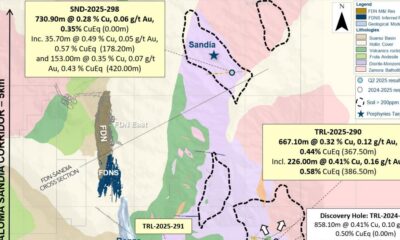
 Nyheter4 veckor sedan
Nyheter4 veckor sedanLundin Gold hittar ny koppar-guld-fyndighet vid Fruta del Norte-gruvan
-

 Nyheter1 vecka sedan
Nyheter1 vecka sedanMeta bygger ett AI-datacenter på 5 GW och 2,25 GW gaskraftverk
-

 Nyheter3 veckor sedan
Nyheter3 veckor sedanGuld stiger till över 3500 USD på osäkerhet i världen
-

 Analys3 veckor sedan
Analys3 veckor sedanWhat OPEC+ is doing, what it is saying and what we are hearing
-

 Nyheter4 veckor sedan
Nyheter4 veckor sedanAlkane Resources och Mandalay Resources har gått samman, aktör inom guld och antimon
-

 Nyheter1 vecka sedan
Nyheter1 vecka sedanAker BP gör ett av Norges största oljefynd på ett decennium, stärker resurserna i Yggdrasilområdet
-

 Nyheter3 veckor sedan
Nyheter3 veckor sedanLyten, tillverkare av litium-svavelbatterier, tar över Northvolts tillgångar i Sverige och Tyskland







